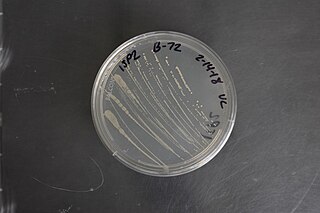Acetic acid bacteria (AAB) are a group of Gram-negative bacteria which oxidize sugars or ethanol and produce acetic acid during fermentation. The acetic acid bacteria consist of 10 genera in the family Acetobacteraceae. Several species of acetic acid bacteria are used in industry for production of certain foods and chemicals.

Mother of vinegar is a biofilm composed of a form of cellulose, yeast, and bacteria that sometimes develops on fermenting alcoholic liquids during the process that turns alcohol into acetic acid with the help of oxygen from the air and acetic acid bacteria (AAB). It is similar to the symbiotic culture of bacteria and yeast (SCOBY) mostly known from production of kombucha, but develops to a much lesser extent due to lesser availability of yeast, which is often no longer present in wine/cider at this stage, and a different population of bacteria. Mother of vinegar is often added to wine, cider, or other alcoholic liquids to produce vinegar at home, although only the bacteria is required, but historically has also been used in large scale production.
Acetobacter is a genus of acetic acid bacteria. Acetic acid bacteria are characterized by the ability to convert ethanol to acetic acid in the presence of oxygen. Of these, the genus Acetobacter is distinguished by the ability to oxidize lactate and acetate into carbon dioxide and water. Bacteria of the genus Acetobacter have been isolated from industrial vinegar fermentation processes and are frequently used as fermentation starter cultures.

Torulaspora delbrueckii is a ubiquitous yeast species with both wild and anthropic habitats. The type strain of T. delbrueckii is CBS 1146T, equivalent to CLIB 230 or ATCC 10662, etc.. The type strain of T. delbrueckii CBS 1146 T was sequenced in 2009, and is composed of 8 chromosomes in addition to a mitochondrial genome.
Acidophiles or acidophilic organisms are those that thrive under highly acidic conditions. These organisms can be found in different branches of the tree of life, including Archaea, Bacteria, and Eukarya.

Kefir is a fermented milk drink similar to a thin yogurt or ayran that is made from kefir grains, a specific type of mesophilic symbiotic culture. It is prepared by inoculating the milk of cows, goats, or sheep with kefir grains.
Alcohol dehydrogenase (quinone) (EC 1.1.5.5, type III ADH, membrane associated quinohaemoprotein alcohol dehydrogenase) is an enzyme with systematic name alcohol:quinone oxidoreductase. This enzyme catalyses the following chemical reaction

Acetobacter aceti, a Gram-negative bacterium that moves using its peritrichous flagella, was discovered when Louis Pasteur proved it to be the cause of conversion of ethanol to acetic acid in 1864. Today, A.aceti is recognized as a species within the genus Acetobacter, belonging to the family Acetobacteraceae in the class Alphaproteobacteria. Its bacterial motility plays an important role in the formation of biofilms, intricate communities where A. aceti cells aggregate and collaborate, further enhancing their ability to metabolize ethanol and produce acetic acid. Widely distributed in various environmental niches, this benign microorganism thrives in habitats abundant in fermentable sugars, such as flowers, fruits, honey, water, and soil, present wherever sugar fermentation occurs. A. aceti grows best within temperatures ranging from 25 to 30 degrees Celsius, with an upper limit of 35 degrees Celsius, and in slightly acidic conditions with a pH between 5.5 to 6.3. A. aceti has long been used in the fermentation industry efficiently producing acetic acid from alcohol as an obligate aerobe dependent on oxygen as the terminal electron acceptor. A. aceti, classified as an acidophile, able to survive in acidic environments, possesses an acidified cytoplasm, providing most proteins with acid stability. The microorganism's ability to thrive in environments rich in fermentable sugars shows its potential as an organism for studying microbial metabolism and adaptation.
Gluconacetobacter sacchari is a species of acetic acid bacteria first isolated from the leaf sheath of sugar cane and from the pink sugar-cane mealy bug on sugar cane growing in Queensland and northern New South Wales. The type strain of this species is strain SRI 1794T. It is notable for its production of bacterial cellulose and for being an endophyte in sugar cane.
Acetobacter cerevisiae is a species of Gram negative acetic acid bacteria. Its type strain is LMG 1625T.
Acetobacter pomorum is a bacterium first isolated from industrial vinegar fermentations. Its type strain is LTH 2458T.
Weissella thailandensis is a species of Gram-positive bacteria. It is a homofermentative, sphere-shaped lactic acid bacteria. Its type strain is FS61-1T. Its genome has been sequenced.
Gluconacetobacter johannae is a species of acetic acid bacteria first isolated from rhizospheres and rhizoplanes of coffee plants. Its type strain is CFN-Cf55T.
Gluconacetobacter azotocaptans is a species of acetic acid bacteria first isolated from rhizospheres and rhizoplanes of coffee plants. Its type strain is CFN-Ca54T.
Candida zemplinina is a yeast species that is osmotolerant, psychrotolerant and ferments sweet botrytized wines. Its type strain is 10-372T.
Acetobacter fabarum is a bacterium that was first identified from fermenting cocoa beans in Ghana.

Gluconobacter is a genus of bacteria in the acetic acid bacteria family. They prefer sugar-rich environments, so are sometimes found as a spoilage organism in beer. They are not known to be pathogenic but can cause rot in apples and pears. They are used alone or with acetobacter for microbial degradation of ethanol
Gluconacetobacter diazotrophicus is a bacterium with a rod-like shape, has rounded ends and belongs to Gram-negative bacteria. The bacterium is known for stimulating plant growth and being tolerant to acetic acid. With one to three lateral flagella, and known to be found on sugarcane, Gluconacetobacter diazotrophicus was discovered in Brazil by Vladimir A. Cavalcante and Johanna Dobereiner.
Komagataeibacter xylinus is a species of bacteria best known for its ability to produce cellulose, specifically bacterial cellulose.




